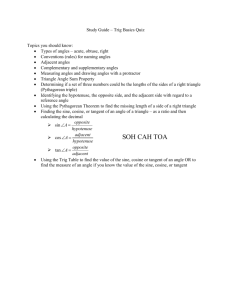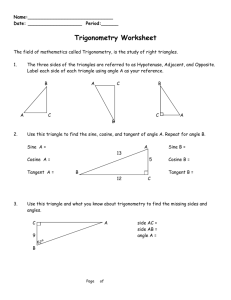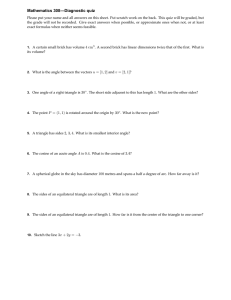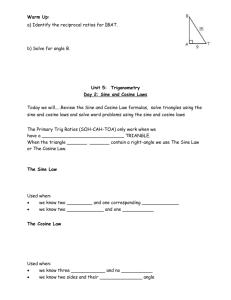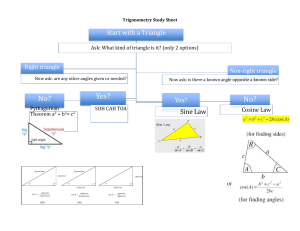Scheme of work – Cambridge IGCSE Mathematics (US) 0444
advertisement
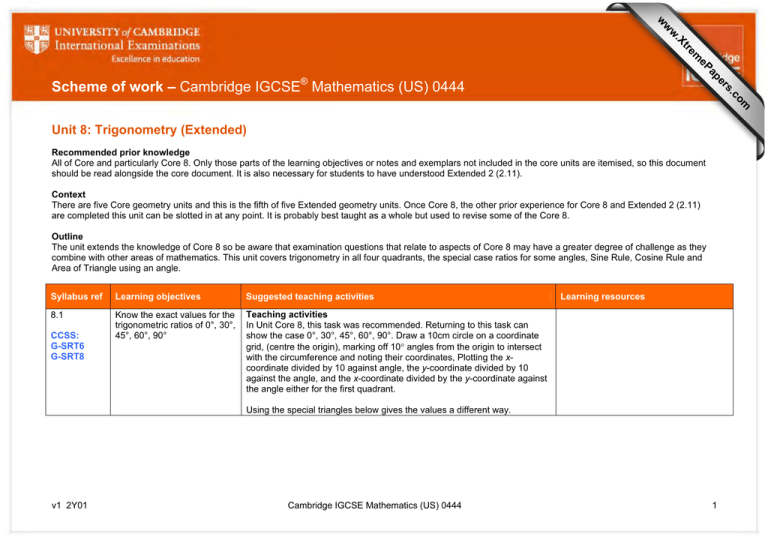
s er ap eP m e tr .X w w w om .c Scheme of work – Cambridge IGCSE® Mathematics (US) 0444 Unit 8: Trigonometry (Extended) Recommended prior knowledge All of Core and particularly Core 8. Only those parts of the learning objectives or notes and exemplars not included in the core units are itemised, so this document should be read alongside the core document. It is also necessary for students to have understood Extended 2 (2.11). Context There are five Core geometry units and this is the fifth of five Extended geometry units. Once Core 8, the other prior experience for Core 8 and Extended 2 (2.11) are completed this unit can be slotted in at any point. It is probably best taught as a whole but used to revise some of the Core 8. Outline The unit extends the knowledge of Core 8 so be aware that examination questions that relate to aspects of Core 8 may have a greater degree of challenge as they combine with other areas of mathematics. This unit covers trigonometry in all four quadrants, the special case ratios for some angles, Sine Rule, Cosine Rule and Area of Triangle using an angle. Syllabus ref Learning objectives Suggested teaching activities 8.1 Know the exact values for the trigonometric ratios of 0°, 30°, 45°, 60°, 90° Teaching activities In Unit Core 8, this task was recommended. Returning to this task can show the case 0°, 30°, 45°, 60°, 90°. Draw a 10cm circle on a coordinate grid, (centre the origin), marking off 10° angles from the origin to intersect with the circumference and noting their coordinates, Plotting the xcoordinate divided by 10 against angle, the y-coordinate divided by 10 against the angle, and the x-coordinate divided by the y-coordinate against the angle either for the first quadrant. CCSS: G-SRT6 G-SRT8 Learning resources Using the special triangles below gives the values a different way. v1 2Y01 Cambridge IGCSE Mathematics (US) 0444 1 Syllabus ref Learning objectives Suggested teaching activities Learning resources isosceles triangle equal side of unit length ∴ x = 45° hypotenuse = 1 x 2 ∴ sin(45°) = cos(45°) = 1 1 2 equilateral triangle sides 2 units ∴ y = 60° and z = 30° z 2 base of right angled triangle is 1 2 height is 3 ∴ sin(30°) = cos(60°) = y ∴sin(60°) = cos(30°) = 8.2 CCSS: G-SRT7 Extend sine and cosine values to angles between 0° and 360° Explain and use the relationship between the sine and cosine of complementary angles Graph and know the properties of trigonometric functions 8.3 CCSS: G-SRT11 Sine Rule 1 2 3 2 Both the visualizations will help students reconstruct diagrams to remind themselves which is which if they have difficulty learning these. Teaching activities This task has already been recommended in Core 8 and for 8.1 above completing the full circle and using co-ordinates will show the positive and negative values in the correct places. Draw a 10cm circle on a coordinate grid, (centre the origin), marking off 10° angles from the origin to intersect with the circumference and noting their coordinates, Plotting the x-coordinate divided by 10 against angle, the ycoordinate divided by 10 against the angle, and the x-coordinate divided by the y-coordinate against the angle either for the first quadrant or for all 360° Drawing any right angled triangle and labelling the lengths a, b, c the angles α and and then writing out statements of the trig functions for α and should convince students about the equivalence of sine and cosine of complementary angles. Notes and exemplars Formula will be given. ASA, SSA (ambiguous case included where the angle is obtuse). General guidance Students need to know the conventions of labelling a triangle to be able to apply the formula - with the lower case letter for the length of the side v1 2Y01 Cambridge IGCSE Mathematics (US) 0444 www.youtube.com/watch?v=APNkWrDU1k www.bbc.co.uk/schools/gcsebitesize/mat hs/shapes/furthertrigonometryhirev1.sht ml 2 Syllabus ref Learning objectives Suggested teaching activities Learning resources opposite the upper case angle. Some students find it hard to find opposite sides so instead describe it as the side that isn’t the two arms of the angle. Past Paper 41 June 2011 Q1bii (syllabus 0580) Teaching activities Use the video to help you construct the proof using white or blackboard more sequentially and completing the trio of equivalences. Ask students to solve missing side and angle problems that require Sine Rule including bearings problems. 8.4 Cosine Rule CCSS: G-SRT11 Notes and exemplars Formula will be given. SAS, SSS. General guidance Students need to know the conventions of labelling a triangle to be able to apply the formula - with the lower case letter for the length of the side opposite the upper case angle. Some students find it hard to find opposite sides so instead describe it as the side that isn’t the two arms of the angle. www.bbc.co.uk/schools/gcsebitesize/mat hs/shapes/furthertrigonometryhirev2.sht ml Past Paper 41 June 2011 Q1bi (syllabus 0580) Past Paper 42 June 2011 Q3c (syllabus 0580) Teaching activities From the video for Sine Rule there is a link to the Cosine Rule. Link the proof solving Quadratic Equations using the formula Extended 2 (2.11) Ask students to solve missing side and angle problems that require Cosine Rule including bearings problems. 8.5 CCSS: G-SRT9 v1 2Y01 Area of triangle Finally give students a bank of mixed problems so that they can distinguish when to use Sine Rule and when to use Cosine rule, i.e. distinguishing between cases where you have the included angle and the case where you don’t have an angle from the others. Notes and exemplars Formula will be given. www.bbc.co.uk/schools/gcsebitesize/mat hs/shapes/furthertrigonometryhirev3.sht ml General guidance Students need to know the conventions of labelling a triangle to be able to apply the formula - with the lower case letter for the length of the side opposite the upper case angle. Some students find it hard to find opposite sides so instead describe it as the side that isn’t the two arms of the angle. Cambridge IGCSE Mathematics (US) 0444 3 Syllabus ref Learning objectives Suggested teaching activities Learning resources You can prove the rule if this is productive but students need practice applying the rule and distinguishing this rule from the sine and cosine rule. v1 2Y01 Cambridge IGCSE Mathematics (US) 0444 4
